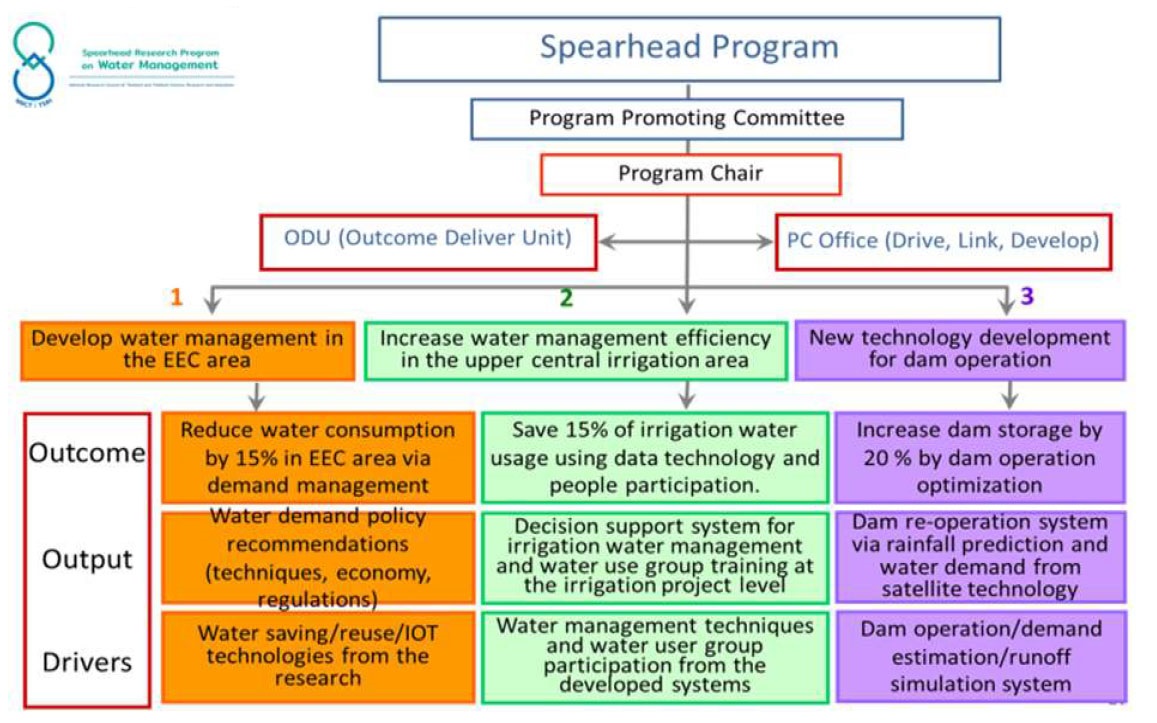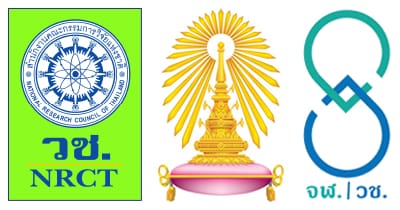ปัญหาการบริหารจัดการน้ำ (ลดาวัลย์,2560) ได้สรุปประเด็นสำคัญไว้ 6 ประการได้แก่ (1) ปริมาณต้องการน้ำมีมากกว่าปริมาณน้ำต้นทุน(มีตัวเลขที่ระบุ ความต้องการใช้น้ำปีละประมาณ 1,500,000 ล้านลบม แต่มีน้ำต้นทุนอยู่ประมาณ93,000 ล้านลบม ต่อปี) เมื่อเกิดภาวะฝนน้อยขึ้นสภาพการขาดแคลนน้ำจะรุนแรงมากขึ้น (2) สภาพภัยแล้ง และน้ำท่วม มีความรุนแรงมากขึ้นโดยเฉพาะในช่วง 10 ปีหลังนี้ ซึ่งอาจโยงกับผลกระทบจากการเปลี่ยนแปลงสภาพภูมิอากาศ (3)ขาดระบบกระจายน้ำจากแหล่งเก็บน้ำสู่พื้นที่ใช้ประโยชน์ และระบบที่มีก็ทรุดโทรมลงมาก (4) การใช้น้ำไม่มีประสิทธิภาพ โดยเฉพาะเมืองใหญ่ยังมีประเด็นน้ำสูญเสียในระบบอยู่ (5) การบริหารน้ำอุปโภค บริโภค ขาดประสิทธิภาพ (ทั้งในแง่ความสูญเสีย คุณภาพน้ำ และการจัดการของอปท.) (6) การบริหารน้ำระดับชาติขาดเอกภาพ (อย่างไรก็ตาม หลังปี 2561 มี พรบ ทรัพยากรน้ำขึ้น มีกลไกในการบูรณการการวางแผนเพื่อตั้งงบประมาณให้ตอบโจทย์และคุ้มค่ามากขึ้น)
water management problems (Ladawan, 2017) has summarized 6 important issues as follows: (1) The amount of water demand is greater than the amount of water costs (there are specified numbers. The demand for water per year is about 1,500,000 million cubic meters, but the cost of water is about 93,000 million cubic meters per year). When there is less rain, the water scarcity condition is more severe. More especially in the last 10 years, which may be linked to the impact of climate change. (3) Lack of water distribution system from the water reservoir to the utilization area. And the existing system is very deteriorated. (4) Inefficient water use. Especially in big cities, there is still the issue of water loss in the system. (5) Inefficient water management. (Both in terms of loss, water quality and management of the local administration) (6) lack of unity in national water management. (However, after 2018, there was an increase in the Water Resources Act. There is a mechanism to integrate planning in order to set a budget that meets the needs and is more cost-effective)
แนวทางการแก้ไขการจัดการน้ำ ภายใต้ข้อจำกัดของทรัพยากรที่มี และความแปรปรวนของสภาพภูมิอากาศ จึงประกอบด้วย การพยายามจัดหาแหล่งน้ำเพิ่มเติม การลดความสูญเสียการส่ง
น้ำ เพื่อให้ส่งน้ำได้ใกล้เคียงกับที่ต้องการทั้งในเชิงปริมาณ พื้นที่และเวลา แนวทางประหยัดการใช้น้ำและการลดปริมาณน้ำเสียที่ปล่อยออกแหล่งน้ำธรรมชาติเพื่อรักษาสภาพแวดล้อม และลดภาระในการส่งน้ำดิบมาเจือจาง ทั้งหมดนี้ต้องมีระบบการจัดการที่เหมาะสม ทั้งแบบผสมผสาน (หลายๆแนวทางด้วยกัน) และทันต่อเวลา (ที่ต้องการโดยใช้เทคโนโลยีสมัยใหม่)
Guidelines for correcting water management under the constraints of available resources and climatic variability therefore contains Efforts to provide additional sources of water transmission loss reduction
water in order to deliver water close to the desired amount in terms of quantity space and time Ways to save water consumption and reduce the amount of wastewater discharged from natural water sources to preserve the environment. and reduce the burden of sending raw water to dilute All this requires a proper management system. both mixed (many methods together) and timely (required using modern technology)
เป้าหมายเชิงยุทธศาสตร์ของการพัฒนาอย่างเป็นมิตรต่อสิ่งแวดล้อม (ยุทธศาสตร์ที่ 5) ต้องการให้เกิดความมั่นคงด้านน้ำใน 5ประเด็น (น้ำชนบท น้ำเมือง น้ำเพื่อการพัฒนา น้ำท่วม/แล้ง คุณภาพน้ำ) การใช้น้ำอย่างมีผลิตภาพ การอนุรักษ์รักษาทางน้ำ และการลดความเสียหายจากอุทกภัย ซึ่งจะมีแผนงานและโครงการต่างๆรองรับเพื่อให้บรรลุสู่เป้าหมายเชิงยุทธศาสตร์
Strategic Goals of Green Development (Strategy at 5) Need to create water security in 5 issues (rural water, urban water, water for development, flood/drought, water quality), productive water use water conservation and reducing damage from flooding There will be various plans and projects to support the achievement of strategic goals.
ในปัจจุบัน การพัฒนาของนวัตกรรมและเทคโนโลยีสมัยใหม่ที่เกิดขึ้นนานาประเทศในระดับสากลได้มีการนำระบบและองค์ความรู้ที่ได้จากนวัตกรรมและเทคโนโลยีสมัยใหม่นี้มาใช้ในการบริหารจัดการน้ำเพื่อเพิ่มประสิทธิภาพอย่างแพร่หลาย (สุภัทรา 2561) อาทิ การนำข้อมูลดาวเทียมเทคนิคสารสนเทศและข้อมูล การเก็บข้อมูลด้วยเซนเซอร์และการส่งข้อมูลด้วยระบบไร้สาย การส่งข้อมูลเตือนภัยในระดับบุคคล ที่เชื่อมโยงกับการบริหารจัดการเขื่อน การจัดการภัยพิบัติ การจัดการในพื้นที่ชลประทานการพัฒนาแพลตฟอร์มเพื่อการจัดการ (น้ำ เกษตร ปัจจัยการผลิต ตลาด เครดิต ฯลฯ)จึงควรทำการศึกษาวิจัยพัฒนาโดยนำแนวคิด แนวทาง และเทคโนโลยีสมัยใหม่เข้ามาช่วยยกระดับการบริหารจัดการน้ำของประเทศและช่วยตอบโจทย์เป้าหมายเชิงยุทธศาสตร์ได้
At present, the development of innovations and modern technologies occurring in many countries at the international level have brought systems and knowledge derived from this innovation and modern technology to use in water management to increase efficiency widely (Supat Ra 2018), such as the use of satellite data, information techniques and information Sensor data acquisition and wireless data transmission Sending alarm information at the personal level linked to the management of the dam disaster management Management in irrigated areas, development of management platforms (water, agriculture, production factors, markets, credit, etc.) should be conducted with research and development by applying new concepts, guidelines and modern technologies to help raise the level of water management in the country and help meet the goals strategic.
ในแผนงานวิจัยเข็มมุ่งด้านการบริหารจัดการน้ำครั้งนี้ได้เลือกประเด็นและพื้นที่ที่มีความสำคัญในการบริหารจัดการน้ำ ซึ่งจะส่งผลต่อการพัฒนาเศรษฐกิจสังคมของประเทศในระยะยาวคือ การบริหารน้ำในเขตพื้นที่พัฒนาพิเศษ EEC การบริหารการปล่อยน้ำของเขื่อนภูมิพลและการบริหารน้ำในโครงการชลประทาน (ท่อทองแดง กำแพงเพชร) เป็นกรณีตัวอย่างเพื่อการยกประสิทธิภาพการใช้น้ำ
In this water management research plan, issues and areas that are important in water management are selected. which will affect the country’s socio-economic development in the long term Water management in the EEC Special Development Area, water release management at Bhumibol Dam and water management in the irrigation project (Copper Pipe, Kamphaeng Phet) are examples for improving water use efficiency.
การพัฒนาพื้นที่พิเศษEEC เป็นแผนพัฒนาหลักหนึ่งของประเทศที่ต้องการให้ประเทศมีการก้าวกระโดดของการพัฒนาเศรษฐกิจและสังคม โดยมีการลงทุนการพัฒนาเทคโนโลยีสมัยใหม่ (S curve, New S-curve) รวมทั้งการพัฒนาเมืองและสาธารณูปโภคแบบทันสมัย น้ำจะเป็นปัจจัยหนึ่งในการพัฒนาพื้นที่นี้เนื่องจากในอดีตการพัฒนาเขตอุตสาหกรรมที่ผ่านมา ได้เคยมีผลกระทบจากด้านทรัพยากรและสิ่งแวดล้อมมาก่อน จนเกิดประเด็นทางสังคมตามมา เช่นภาวะแล้งในปี 2548,2563 จึงจำเป็นต้องศึกษาทบทวน และถ้ามีประเด็น จะได้หามาตราการรองรับไว้ล่วงหน้าเพื่อป้องกันปัญหาในอนาคต
Development of EEC special areas It is one of the main development plans of the country that wants the country to leap forward in economic and social development. by investing in the development of modern technology (S curve, New S-curve), as well as the development of modern cities and public utilities Water will be one factor in the development of this area due to the development of industrial zones in the past. have had impacts from resources and the environment before until a social issue arises such as the drought in 2005, 2020, therefore, it is necessary to study and review and if there is an issue will find support measures in advance to prevent future problems.
การบริหารเขื่อนมีความสำคัญทั้งในแง่ของการเก็บกักน้ำในฤดูแล้งและการช่วยบรรเทาภาวะน้ำท่วมในฤดูฝน ซึ่งเป็นการบริหารที่มีขัดแย้งกันเอง การบริหารเขื่อนต้องตัดสินใจบนพื้นฐานของวัตถุประสงค์หลายด้าน และต้องการเครื่องมือและข้อมูลประกอบที่เพียงพอและทันกาล ในการศึกษาครั้งนี้ได้เลือกการบริหารเขื่อนภูมิพลเป็นโครงการนำร่องในการวิจัยพัฒนา
Dam management is important both in terms of storing water in the dry season and helping to mitigate flooding in the rainy season. which is an administration that has conflicts among themselves The management of dams must be decided on the basis of several objectives. and requires adequate and timely supporting tools and information In this study, the management of Bhumibol Dam was selected as a pilot project for research and development.
การใช้น้ำในภาคเกษตรเป็นผู้ใช้น้ำรายใหญ่และมีประชากรในภาคเกษตรที่เกี่ยวข้องเป็นจำนวนมาก การประหยัดน้ำในภาคเกษตรจะส่งผลต่อปริมาณน้ำต้นทุนและการใช้น้ำเป็นอย่างมากโครงการวิจัยในแผนงานนี้ภายใต้ความร่วมมีอจากกรมชลประทานได้คัดเลือกโครงการชลประทานท่อทองแดง จังหวัดกำแพงเพชรเป็นโครงการนำร่องในการนำเทคโนโลยีเข้าช่วยในการบริหารจัดการน้ำ
Water use in the agricultural sector is a major water user and there is a large number of people involved in the agricultural sector. Saving water in the agricultural sector will greatly affect the amount of water, cost and use of water. A research project in this program under the cooperation of the Royal Irrigation Department has selected a copper pipe irrigation project. Kamphaeng Phet Province is a pilot project in bringing technology to help manage water.
เป้าหมายของกลุ่มวิจัยทั้งสามของการบริหารจัดการน้ำที่จะดำเนินการใน 3 ระยะกำหนดไว้ดังนี้
– กลุ่มวางแผนน้ำพื้นที่ EEC : ลดอัตราการใช้น้ำคาดการณ์ในพื้นที่EEC ลงร้อยละ 15 ของความต้องการใช้น้ำเปรียบเทียบกับข้อมูลคาดการณ์ความต้องการใช้น้ำที่เพิ่มขึ้นในพื้นที่EEC
– กลุ่มบริหารเขื่อน : เพิ่มประสิทธิภาพการปล่อยน้ำต้นทุนจากเขื่อนในเขตพื้นที่ภาคกลางตอนบนใต้พื้นที่เขื่อนภูมิพลและเขื่อนสิริกิติ์ขึ้นจากร้อยละ 65 เป็นร้อยละ 85
– กลุ่มบริหารน้ำในเขตชลประทาน: ลดค่าเฉลี่ยการสูญเสียจากการส่งน้ำในระบบส่งน้ำ (ในภาคการเกษตร) ในกลุ่มพื้นที่ภาคกลางตอนบนลดลงจากร้อยละ 30 เหลือร้อยละ 15 จากอัตราปัจจุบัน
The goals of the three research groups of water management to be implemented in 3 phases are defined as follows.
– Water planning group in the EEC area: Reduce the estimated water consumption rate in the EEC area by 15% of the water demand compared to the forecasted increase in water demand in the EEC area.
– Dam Management Group: Increase the efficiency of water release from dams in the upper central region under the Bhumibol Dam and Sirikit Dam from 65 percent to 85 percent.
– Water Management Group in Irrigation Areas: Reduce the average loss from water delivery in the irrigation system. (In agriculture) in the upper central region decreased from 30 percent to 15 percent from the current rate.
โดยมีแนวคิดในการพัฒนาเทคนิคและระบบใหม่ให้เชื่อมโยงกับระบบวางแผน/บริหารน้ำในปัจจุบัน และ เลือกประเด็นที่สำคัญมาพัฒนาเทคนิค เพื่อกลับเข้าไปใส่ในระบบที่มีอยู่ด้วยเทคนิคใหม่ได้ และ พัฒนาการเชื่อมโยงของระบบ และทดลองการรันไปคู่ขนานกับระบบปัจจุบันเพื่อการทดสอบได้แนวทางการทำวิจัยในปีที่ 1 เป็นการวิจัยพัฒนาต้นแบบ (prototype) และปีที่ 2 เป็นการประยุกต์ใช้(application) ร่วมกับหน่วยงานปฏิบัติ และการวิจัยเพิ่มปีที่ 3 เป็นการวิจัยเสริมพร้อมการถ่ายทอด(transfer) ผลงานวิจัยให้กับหน่วยงานปฏิบัติต่อไป โดยมีเป้าหมายปีที่ 1ของแต่ละกลุ่มวิจัยกำหนด ไว้ ดังนี้
– กลุ่มการจัดการน้ำในพื้นที่ EEC
สนับสนุนการประหยัดน้ำในภาคอุตสาหกรรม(จากโรงงานตัวอย่าง) พร้อมจัดทำข้อเสนอแนะเชิงนโยบายด้านการประหยัดน้ำในพื้นที่
– กลุ่มการพัฒนาเทคโนโลยีช่วยในการบริหารเขื่อน
พัฒนาแบบจำลองบริหารเขื่อนภูมิพล พร้อมการพัฒนาการทำนายฝน 14 วันที่แม่นยำขึ้น เพื่อเพิ่มปริมาณน้ำต้นทุนก่อนเข้าฤดูแล้ง
– กลุ่มการจัดการน้ำในโครงการชลประทาน
การจำลองการจัดสรรน้ำเพื่อการประหยัดน้ำด้วยเครื่องมือทันสมัย และการพัฒนากลุ่มผู้ใช้น้ำ
The idea is to develop new techniques and systems to be linked to the current water planning/management system. and select important issues to develop techniques to be re-inserted into existing systems with new techniques and develop the linkage of the system And try to run it in parallel with the current system for testing. Research guidelines in the 1st year are research and development of prototypes (prototype) and the 2nd year are applications (application) with practical agencies. and additional research for the 3rd year It is supplementary research with the transfer of research results to further practice agencies. The goals of the 1st year of each research group are set as follows:
– Water management group in the EEC area
Support water saving in the industrial sector (from model factories) and make policy recommendations on water saving in the area.
– Technological development group to assist in the management of the dam
Bhumibol Dam Management Model Development with the development of a more accurate 14-day rain forecast to increase the amount of water costs before the dry season
– Water management group in irrigation projects
Simulation of water allocation for water saving with modern tools and the development of water user groups
ซึ่งการเลือกประเด็นวิจัยและเทคนิคที่จะใช้ เกิดจากการทบทวนนโยบาย การศึกษาที่ผ่านมา และการตั้งวงเสวนาจากผู้ทรงคุณวุฒิเพื่อสรุปประเด็น แนวทางและเทคนิคที่ควรวิจัยทดลองเพื่อให้บรรลุเป้าหมายได้ จากนั้นก็เป็นการออกแบบระบบการบริหารงานวิจัย การสรรหาทีมงานวิจัย ที่มีประวัติและประสบการณ์ดำเนินการมาก่อนแล้ว ในการดำเนินงาน จะมีการทบทวนและปรับ ขอบเขตและวิธีการทำงานกันในระหว่างการทำวิจัยตามความต้องการของผู้ใช้งาน ข้อมูลที่ได้มา เพื่อให้ได้เป้าหมาย รวมทั้งการสร้างกลไกการเรียนรู้ร่วม การแลกเปลี่ยนกับผชช. ตปท. การขับเคลื่อนกับหน่วยงานใช้ประโยชน์เป็นระยะ แผนงานวิจัยฯเป้าหมาย กลไก กลุ่มงานและตัวขับเคลื่อนของแผนงานวิจัย สรุปได้ตามรูปข้างล่างนี้
which the selection of research topics and techniques to be used arising from the policy review, past studies and setting up a discussion group from experts to summarize the issues Guidelines and techniques that should be researched and tested to achieve the goal. Then it is the design of the research management system. research team recruitment that have a history and experience in the past will be reviewed and adjusted The scope and methods of working during the research are based on the needs of the users. acquired information to get the goal as well as creating a co-learning mechanism Exchanges with foreign participants, periodic utilization of agencies, research plans, targets, mechanisms, working groups and drivers of the research program. It can be summarized as shown in the figure below.

คณะทำงานเว็บไซต์
| ชื่อ-นามสกุล | ตำแหน่ง | เบอรืโทรศัพทื | อีเมลล์ |
| ดร.นัชชา ผลพอตน Dr.Nuchcha Phonphoton | บรรณาธิการ | 0-2244-3000 ต่อ 5814 | [email protected] |
| คุณเตชินี สิริธนะบดี Miss Techini Siritanabod | ผู้ช่วยบรรณาธิการ | 092-824-6615 | [email protected] |
| คุณศักย์ สกุลไทย Mr.Sak Sakulthai | ผู้จัดทำเว็บไซต์ | 089-798-9545 | [email protected] |
| คุณดือนเพ็ญ ปุณยางกูร Miss Duanpen Punayangkool | เลขานุการ | 02-218-6425 | [email protected] |
